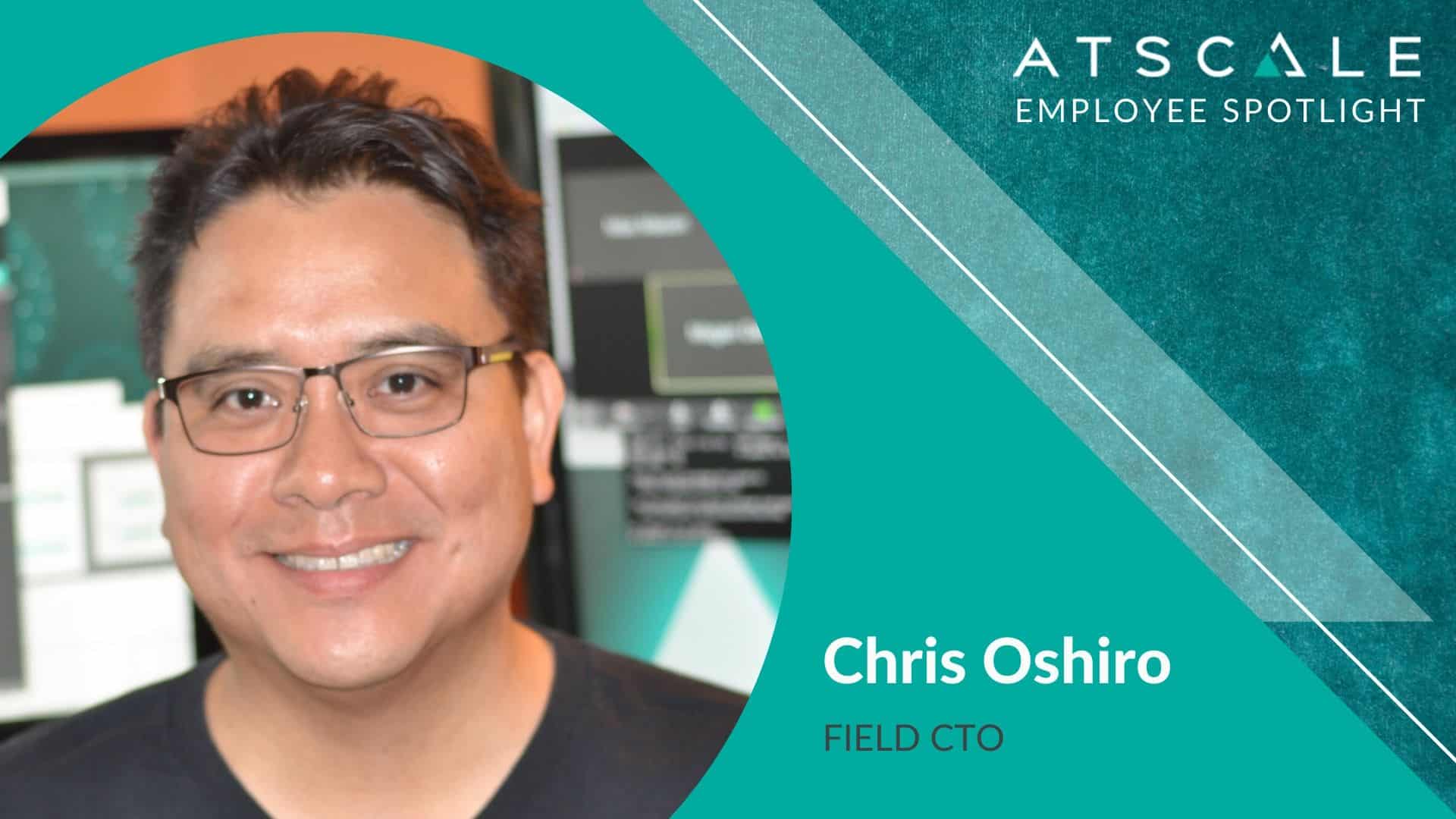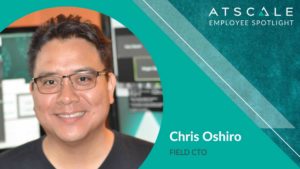

At AtScale, everything that we achieve is because of the collaboration among our team. Today, we introduce you to Chris Oshiro who has been a part of the AtScale team for the last four years.
What is your role at AtScale?
A: I’m the Field CTO which means that I am the “technical arm” on any type of sales opportunity. My responsibility is to make sure that whatever the field is asking for, it’s being prioritized along with market requirements and other types of commitments that we’ve made. So I’ve got one foot in product management and another foot in sales.
What excites you about your role?
A: This is a new role for me that I just started in November 2019. Scott Howser, AtScale’s Chief Product Officer, and Chris Lynch, AtScale’s CEO, identified me as the person to prioritize some of the product commitments and priorities for AtScale based directly on what we hear from our customers which I am really excited about. It’s the first time that I really have to put my product hat on. I listen to our customers and our salespeople, and I also have to make sure that I’m very aware of what’s going on in the marketplace. In my perspective, I’ve kind of always done those things, but now I’m officially responsible for doing it. That’s something new in my career and that’s exciting.
How and where did you get your start in this industry?
A: I graduated with a computer science degree and I started working directly with business intelligence and predictive analytics. I started with a company called Information Builders out of New York where I actually stayed for eleven years. In retrospect, that’s a long time for anyone to stay with a company. I did it because one of the things that the company allowed me to do was shift roles about every two years. It gave me the time to really figure out what I wanted to do when I grew up. My last role there was in sales engineering, and I’ve remained in sales engineering for a long time. At AtScale, when I was asked “Why don’t you try this as well?” I did.
What makes AtScale and our approach unique?
A: The AtScale approach is unique because what we are doing with analytics that we’re really good at is frankly a fairly old fashioned concept. The idea of OLAP and multidimensional analytics is not new. That technology has been out there for a really long time. The difference for AtScale is how we take these mission-critical concepts and really scale them up for today’s type of environment. In the last five to eight years, there’s been a tremendous evolution with technology for data storage, data lakes and cloud data warehouses. The challenge was that technology was moving so fast, that the marketplace forgot about data analytics and how data analytics works on those new data platforms. AtScale said “Hey, hold up a second. Before you start scaling petabytes of data, we need to think about how to take that data and make it mission-critical and mission-friendly.” AtScale came in and did that. That’s who we are. We’re bridging this analytical concept that is still incredibly important and leveraging it to help our customers perform analytics in a really scalable, cloud-friendly, secure manner. Every company will always need what we do.
In your opinion, what are the top three Big Data buzzwords that need a new definition in 2020?
A: The buzz words for Big Data need to be redefined because they started with the concept of Hadoop and distributed systems and how we store live data. This has evolved from having data on premises and cloud. When people talk about the Cloud, they’re really talking about Big Data as well. So, Big Data is one of the first terms that we need to redefine when we’re talking about large, scaled data, wherever it lies. I’m not exactly sure what that buzzword should be, but Big Data implies an older concept. The other one is the term “Scalability” and it’s right in our name. When people think of scale, the first thing that they think of is “a lot” of storage. Scale actually comes into play in multiple ways: the scalability of the amount of data, the scalability of a lot of users, and the need to be able to use your product and deploy it quickly That kind of agility lends itself to scale as well because we’re talking about the scalability of adoption. So, when we think about scale, let’s not just think about it in terms of a lot of data. It’s actually a lot of everything and AtScale early on made the decisions of how we deal with a lot of data, the speed that data is moving, and all of the people using it. It’s not just about the amount of data. The last buzzword that needs a new definition, would be OLAP, just because it’s an old term. People hear the word OLAP and they think that’s old-fashioned. It is. The acronym is horrendous because it stands for Online Analytical Processing, but what really what it means is that to combine multiple data sets so that the business can understand it and can be really performant. That’s really important. I think we need to find a new way of saying OLAP without losing the term because it’s still very relevant. So, we’re talking about COLAP these days.
Let’s talk about OLAP, specifically OLAP on Cloud Data Warehouses or “COLAP”. How did AtScale “reinvent” the OLAP engine for the Cloud?
A: AtScale developed “Autonomous Data Engineering™.” From a COLAP perspective, COLAP starts off with advanced business modeling, meaning that you have a fact dimensional model with data coming from multiple locations. This could be sales data, social media data, or other data that comes in live with some commonality of dimensions and attributions. For example, someone who walks in the store may also buy something online, and also tweets about it. This is a customer-360 example of COLAP. Once you start building out COLAP in dimensional modeling, there’s a lot of difficult relationships between a transactional system that understands fact-level data versus dimensions. For example, someone may live in a postal code or they may live in multiple postal codes and they might belong in different regions so there’s a lot of complicated stuff around their data. In the past, in order to deal with OLAP analytics, because of the complexity, technologies used to do a lot of ETL and materialization such that the analytics became performant. AtScale looked at the Big Data market and the Cloud market, We created Autonomous Data Engineering as “on-demand data engineering”. That means that our customers can keep the complexity of the data modeling and business analytics, and they can scale to Big Data, Cloud and Hybrid Cloud because we are not tied to ETL for the data. That’s what makes AtScale very different in the world of COLAP.
Do you have anything to say to Cloud skeptics?
A: It’s not so much about being skeptical about the cloud, it’s a matter of identifying which cloud to go for which of workloads that our customers have. The reality is that a lot of people didn’t want to go to the Cloud before because of security. We know now that Cloud security is better than what most organizations can have in their data centers. Anyone who was a cloud skeptic, they’re past security concerns and they’re at a stage of figuring out which cloud does what. It makes good sense to invest in technologies like AtScale that work in a hybrid cloud environment.
Describe AtScale in three words.
A: Quirky, Smart and Passionate.
How have you seen AtScale’s product evolve in your soon to be five years with the company?
A: I’ve been lucky to see AtScale completely evolve. I joined AtScale a couple months after our product became generally available for the public. It’s evolved from being OLAP on Hadoop to much more than that. I’ve been able to witness the rise of cloud databases and intelligent data virtualization. One of the nice things about this evolution is that it has been driven by AtScale internally, as well as market driven. We’ve had customers say, “Hey, we love your product but we’re headed over here.How can you help us get there? Can you stay with us on this journey?”
Who benefits from using our technology?
A: Data analysts who are trying to answer complex questions for their leadership need to have confidence that they have access to all of their data at speed and that they don’t have to reinvent the wheel when they need to ask a question. Those types of folks can be anyone who works with a dashboard to a developer who is building sophisticated assets and are using a data service powered by AtScale. The abstraction layer that AtScale provides while providing security and performance is really important for users to use in a confident and scalable way.
When you’re not in the office, where will people most likely find you?
A: For the next three months, probably at home. But in reality, it’s not that different from that. I have three kids, who have their own individual endeavors and passions, so my wife and I are following them wherever that may be.


SHARE
Guide: How to Choose a Semantic Layer